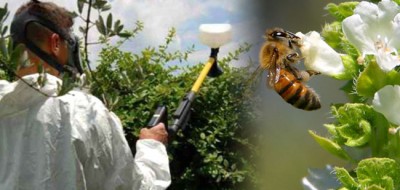EPA: Three Popular Neonicotinoid Pesticides Likely to Drive More Than 200 Endangered Plants, Animals Extinct

All Global Research articles can be read in 51 languages by activating the Translate Website button below the author’s name.
To receive Global Research’s Daily Newsletter (selected articles), click here.
Click the share button above to email/forward this article to your friends and colleagues. Follow us on Instagram and Twitter and subscribe to our Telegram Channel. Feel free to repost and share widely Global Research articles.
***
An assessment released today by the Environmental Protection Agency found that three popular neonicotinoid insecticides are likely to jeopardize the continued existence of more than 200 plants and animals protected under the Endangered Species Act. This includes 25 insect species and more than 160 plants dependent on insect pollination.
The new finding on clothianidin, imidacloprid and thiamethoxam comes one year after the agency completed biological evaluations on the pesticides. Those assessments found that the vast majority of endangered species — 1,225 (67% of all endangered species) for clothianidin, 1,445 (79%) for imidacloprid, and 1,396 (77%) for thiamethoxam — were likely harmed by these three insecticides.
Today’s finding focuses on which species are likely to be driven extinct by these three insecticides. These imperiled species include Attwater’s greater prairie-chicken, rusty patched bumblebee, Karner blue butterfly, American burying beetle, Western prairie fringed orchid, vernal pool fairy shrimp and the spring pygmy sunfish.
“The EPA’s analysis shows we’ve got a five-alarm fire on our hands, and there’s now no question that neonicotinoids play an outsized role in our heartbreaking extinction crisis,” said Lori Ann Burd, environmental health director at the Center for Biological Diversity. “The EPA has to use the authority it has to take fast action to ban these pesticides so future generations don’t live in a world without bees and butterflies and the plants that depend on them.”
Neonicotinoids, which are banned in the European Union, are the most popular insecticides in the United States. Hundreds of studies have shown they play a major role in population-level declines of bees, birds, butterflies and freshwater invertebrates. More recent studies found they cause significant harm to mammals as well.
The analysis released today found that 166, or 9% of all endangered species, are likely to be jeopardized by clothianidin.
For imidacloprid, 199 species, or 11% of all endangered plants and animals, are likely to be jeopardized.
Thiamethoxam was found to likely jeopardize the continued existence of 204, or 11% of all endangered species.
“Given the Fish and Wildlife Service’s refusal to lift a finger to protect endangered species from pesticides, we commend the EPA for completing this analysis and revealing the disturbing reality of the massive threat these pesticides pose,” said Burd. “The Biden administration will have the stain of extinction on its hands if it doesn’t muster the courage to stand up to Big Ag and ban these chemicals.”
Pollinator populations are declining nationwide. The American bumblebee, once the most common bumblebee species in the United States, has declined by an estimated 89% in just the past 20 years. The Center has petitioned for Endangered Species Act protection for the American bumblebee.
Neonicotinoids are used on hundreds of millions of acres of agricultural lands across the country. They can be directly sprayed or injected and are commonly used as coatings on seeds such as corn and soy, which are planted on hundreds of millions of acres each year.
The insecticides are systemic, meaning they are absorbed by plants, making the entire plant deadly toxic, including its nectar, pollen and fruit. Neonicotinoids are also highly persistent and can linger in soil for years, causing long-term harm.
Imidacloprid is one of the two active ingredients in Seresto flea collars, which have been linked to the deaths of nearly 2,700 family pets. A scathing report released by the House Committee on Oversight and Reform’s Subcommittee on Economic and Consumer Policy chastised the EPA for ignoring evidence of the collar’s harm. The report called for the agency to ban the pesticide-impregnated collar.
The EPA has yet to take action on a Center petition to ban the collar, despite soliciting public input on the matter nearly two years ago.
Authors of a major scientific review of the catastrophic decline of insects have said a “serious reduction in pesticide usage” is key to preventing the extinction of up to 41% of the world’s insects in the next few decades.
For decades the EPA has refused to comply with its Endangered Species Act obligations to assess pesticides’ harms to protected species. The agency was finally forced to do the biological evaluations by legal agreements with the Center for Food Safety and the Natural Resources Defense Council. After losing many lawsuits on this matter, the EPA has committed to work toward complying with the Act.
*
Note to readers: Please click the share button above. Follow us on Instagram and Twitter and subscribe to our Telegram Channel. Feel free to repost and share widely Global Research articles.

